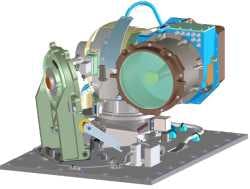Researchers from the Massachusetts Institute of Technology’s (MIT) Lincoln Laboratory (Lexington, MA), working with NASA in the fall of 2013, first demonstrated an Earth-to-moon laser-based broadband data communication technology; now, at CLEO: 2014 (June 8-13; San Jose, CA), the team will present new details and the first comprehensive overview of the on-orbit performance of the communication uplink between the moon and Earth, which beat the previous record transmission speed last fall by a factor of 4800. Earlier reports stated what the team accomplished, but did not provide the details of the implementation.
The researchers made history last year when their Lunar Laser Communication Demonstration (LLCD) transmitted data over the 384,633 km between the moon and Earth at a download rate of 622 Mbit/s—faster than any radio frequency (RF) system. They also transmitted data from the Earth to the moon at 19.44 Mbit/s, a factor of 4800 times faster than the best RF uplink ever used.
To outmaneuver problems with fading of the signal over such a distance, the demonstration uses several techniques to achieve error-free performance over a wide range of optically challenging atmospheric conditions in both darkness and bright sunlight.
Four ground telescopes reduce atmospheric turbulence effects
A ground terminal at White Sands, New Mexico, uses four separate telescopes to send the uplink signal to the moon. Each telescope is about 6 in. in diameter and fed by an IR laser transmitter. The total transmitter power the sum of the four separate transmitters) is 40 W. Each of the four telescopes transmits light through a different column of air that experiences different refraction effects from the atmosphere; this increases the chance that at least one of the laser beams will interact with the receiver, which is mounted on a satellite orbiting the moon.
The receiver uses a slightly smaller telescope to collect the light, which is then focused into an optical fiber, amplified by a factor of 30,000, and measured by a photodetector. Of the original 40 W signal sent by the transmitter, less than a nanowatt is received—still about ten times the signal necessary to achieve error-free communication.
"We demonstrated tolerance to medium-size cloud attenuations, as well as large atmospheric-turbulence-induced signal power variations, or fading, allowing error-free performance even with very small signal margins," says Mark Stevens of MIT Lincoln Laboratory.
While the LLCD design is directly relevant for near-Earth missions and those out to Earth's Lagrange points, the team predicts that it will be extendable to deep-space missions to Mars and the outer planets.
Presentation SM4J.1, titled "Overview and On-orbit Performance of the Lunar Laser Communication Demonstration Uplink," will take place Monday, June 9, at 4:00 p.m. in Meeting Room 212 A/C of the San Jose Convention Center.

